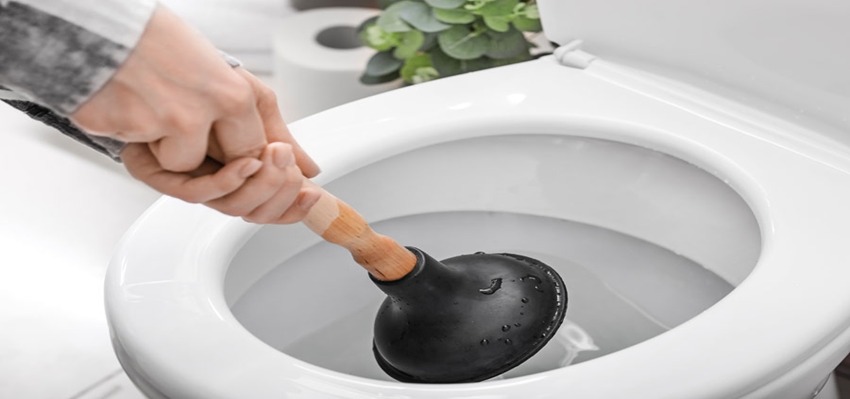Dealing with a toilet overflow can be a stressful and messy situation. Knowing how to unclog an overflowed toilet swiftly and efficiently is essential for maintaining a functional and hygienic bathroom. This article provides practical and professional solutions to tackle this common household problem. By understanding the cause of the overflow, taking immediate preventive actions, and employing effective tools and methods, you can resolve the issue quickly and restore your toilet to proper working condition.
Assessing the Situation: Understanding the Cause of Overflow
When faced with a toilet overflow, the first step is to assess the situation and understand the underlying cause. Knowing how to unclog an overflowed toilet begins with identifying the source of the problem. Common causes of toilet overflows include blockages from foreign objects, excessive toilet paper, or issues within the plumbing system.
To determine the extent of the issue, check if the problem is isolated to one toilet or affects multiple fixtures in the house. If multiple fixtures are involved, the issue might be with the main sewer line rather than just the toilet. Understanding these details is crucial for selecting the appropriate solution and preventing further complications. Assessing the situation accurately allows you to take informed steps toward resolving the overflow efficiently and effectively.
Immediate Actions: Stopping the Overflow
Once you have assessed the situation and identified the potential cause, the next crucial step is to stop the overflow immediately. This step is vital to prevent further water damage and to give you time to address the clog effectively. Here are detailed steps to halt the overflow:
- Remove the Tank Lid: Carefully take off the toilet tank lid and place it somewhere safe. Inside the tank, locate the flapper valve a rubber part that covers the flush valve opening.
- Push Down the Flapper: Press the flapper valve down to stop additional water from entering the toilet bowl. This action should halt the water flow, giving you time to manage the clog without the bowl filling up further.
- Turn Off the Water Supply: If the overflow persists or you cannot access the flapper valve quickly, locate the water supply valve. This valve is usually found behind the toilet, near the floor. Turn the valve clockwise to shut off the water supply completely. This step ensures no more water can enter the toilet, preventing further spillage.
- Sop Up Excess Water: Use towels or a mop to soak up any water that may have overflowed onto the floor. This prevents water damage to your bathroom and reduces the risk of slips and falls.
- Ventilate the Area: Open windows or use an exhaust fan to ventilate the bathroom. This helps to reduce odors and dry out any dampness caused by the overflow.
Taking these immediate actions helps to contain the mess and prevent additional stress while you work on unclogging the toilet. With the water stopped, you can proceed to address the clog without the added pressure of dealing with continuous overflow. This methodical approach not only minimizes water damage but also provides a clear space for you to tackle the underlying issue.
Utilizing a Plunger: The First Line of Defense
A plunger is one of the most effective and commonly used tools for unclogging toilets. Knowing how to unclog an overflowed toilet often begins with this simple yet powerful tool. Here are the steps to use a plunger effectively:
- Choose the Right Plunger: Ensure you have a flange plunger, also known as a toilet plunger. This type has an additional soft rubber flap (or flange) that folds out from the inside of the cup, providing a better seal for toilet drains.
- Prepare the Area: Place old towels or newspapers around the base of the toilet to catch any water that might splash out during plunging. Wearing rubber gloves can also protect your hands from any bacteria or debris.
- Position the Plunger: Insert the plunger into the toilet bowl, making sure the flange fits snugly into the drain opening. The plunger should be completely submerged in water to create the necessary suction. If there isn’t enough water in the bowl, add some to ensure the plunger is covered.
- Plunge Effectively: Push the plunger down gently at first to expel any air trapped in the bell. Then, use a series of forceful pushes and pulls, maintaining the seal over the drain. The goal is to create a vacuum that will dislodge the clog. It may take several attempts, so be patient and persistent.
- Test the Flush: After a few vigorous plunges, remove the plunger and check if the water begins to drain. If the clog seems to be clearing, try flushing the toilet. Be cautious and ready to stop the water flow if the toilet starts to overflow again.
- Repeat if Necessary: Some clogs might require multiple rounds of plunging. If the water drains slowly or not at all, repeat the plunging process. Sometimes, a particularly stubborn clog might take several attempts to clear completely.
Using a plunger is often the first and most effective step in addressing a clogged toilet. It can quickly resolve most minor blockages, restoring normal function without the need for more invasive methods. Remember, the key is to create a strong seal and use controlled, forceful movements to dislodge the obstruction.
Employing a Toilet Auger: Handling Stubborn Clogs
When a plunger isn’t enough to clear a stubborn clog, a toilet auger, also known as a plumbing snake, becomes an essential tool. Understanding how to unclog an overflowed toilet often involves using this specialized device to reach deeper blockages. Here’s how to use a toilet auger effectively:
- Select the Right Auger: Ensure you have a toilet auger, which is specifically designed for toilets. It features a flexible, coiled wire with a crank handle that allows you to extend the auger into the toilet drain.
- Prepare the Area: Just like with plunging, place old towels or newspapers around the base of the toilet to catch any water or debris. Wear rubber gloves to protect your hands from bacteria and contaminants.
- Insert the Auger: Gently insert the auger into the toilet bowl, guiding the curved end into the drain opening. Be careful not to scratch the porcelain surface of the toilet. The auger’s protective coating helps prevent damage.
- Extend the Cable: Once the auger is positioned, begin turning the crank handle clockwise. This action will extend the coiled wire into the drain. Continue cranking until you encounter resistance, which indicates that the auger has reached the blockage.
- Break Up the Clog: When you feel resistance, continue turning the handle to break up or hook onto the clog. The auger’s tip is designed to either pull the blockage back out or push it through the drain. You may need to push and pull the auger gently to work through the obstruction.
- Retract the Auger: After you feel the clog has been dislodged, slowly retract the auger by turning the handle counterclockwise. Be prepared for some water or debris to come up with the auger.
- Flush the Toilet: Once the auger is fully retracted, flush the toilet to ensure the water flows freely. If the toilet still drains slowly, you might need to repeat the process. If the water flows normally, the clog has been successfully cleared.
Using a toilet auger is a reliable method for handling clogs that are too stubborn for a plunger. This tool reaches deeper into the plumbing system, effectively breaking up or removing blockages that lie further down the drain. With a bit of patience and careful handling, a toilet auger can restore your toilet to proper working order, ensuring a smooth and clog-free flush.
Using Household Solutions: Safe and Effective Methods
For those who prefer eco-friendly and readily available options, household solutions can be quite effective in unclogging an overflowed toilet. Knowing how to unclog an overflowed toilet using these common items can save time and money. Here are some tried-and-true methods using household materials:
- Hot Water and Dish Soap: Start by pouring a generous amount of dish soap into the toilet bowl. The soap acts as a lubricant, helping to break down greasy clogs. Next, heat a bucket of water to a hot (but not boiling) temperature. Carefully pour the hot water into the toilet bowl from waist height. The force of the water, combined with the dish soap, can help dislodge minor clogs. Let it sit for a few minutes and then try flushing the toilet.
- Baking Soda and Vinegar: This classic combination creates a fizzy reaction that can break down blockages. Pour one cup of baking soda into the toilet bowl, followed by one cup of vinegar. The mixture will fizz and bubble, helping to loosen the clog. Allow it to sit for about 30 minutes. Afterward, flush the toilet with hot water. This method is not only effective but also environmentally friendly.
- Epsom Salt and Hot Water: If you have Epsom salt on hand, it can be a helpful tool. Pour a generous amount of Epsom salt into the toilet bowl. The salt will react with the water, helping to dissolve and break up the clog. Follow this by pouring a bucket of hot water into the bowl to further assist in clearing the blockage. Let it sit for a while before attempting to flush.
- Wet/Dry Vacuum: If you have access to a wet/dry vacuum, it can be a powerful tool for unclogging a toilet. Set the vacuum to “liquid” mode, ensuring it is properly sealed to prevent messes. Place the vacuum hose into the toilet bowl, creating a strong seal around the drain opening. Turn on the vacuum to suck out the clog. This method can be particularly effective for solid obstructions.
- Enzyme-Based Drain Cleaners: For a more gradual but effective solution, consider using enzyme-based drain cleaners. These cleaners contain natural enzymes that break down organic waste. Pour the recommended amount into the toilet bowl and let it sit overnight. Enzyme-based cleaners are safe for plumbing and the environment, making them a good option for maintaining clear pipes.
Utilizing household solutions offers a safe, cost-effective way to address minor toilet clogs without resorting to harsh chemicals. These methods not only help clear the blockage but also minimize the risk of damage to your plumbing system. By incorporating these simple solutions into your routine, you can maintain a functional and clog-free toilet.
Preventative Measures: Avoiding Future Clogs
Once you’ve successfully unclogged your toilet, it’s essential to take steps to prevent future overflows. Knowing how to unclog an overflowed toilet is important, but preventing clogs from happening in the first place can save time and frustration. Here are some effective preventative measures:
- Mindful Flushing: Educate all household members about what can and cannot be flushed. Only flush human waste and toilet paper. Items like sanitary products, wet wipes (even those labeled as flushable), paper towels, and cotton balls should be disposed of in the trash. These items can easily cause blockages.
- Use Less Toilet Paper: Encourage the use of moderate amounts of toilet paper. Excessive toilet paper can accumulate and cause clogs. If necessary, consider using thinner toilet paper or teaching children to use less with each flush.
- Regular Maintenance: Regularly inspect and maintain your toilet and plumbing system. Periodic checks can help identify potential issues before they become serious problems. For example, checking the water level in the tank and ensuring the flapper is functioning correctly can prevent overflows.
- Install a Drain Guard: Consider installing a drain guard in your toilet to catch any foreign objects that might accidentally be dropped into the bowl. This simple device can help prevent items from entering the plumbing system and causing blockages.
- Routine Cleaning: Clean your toilet regularly with appropriate cleaning agents to prevent buildup. Avoid using harsh chemicals that can damage your plumbing over time. Natural cleaners like vinegar and baking soda not only clean effectively but also help keep your pipes clear.
- Be Cautious with DIY Fixes: While DIY solutions can be effective, avoid using chemical drain cleaners frequently as they can damage pipes. Instead, use mechanical methods like plungers or augers for clogs. If you experience recurring clogs, it may be a sign of a more serious underlying issue that requires professional attention.
- Schedule Professional Inspections: Regular inspections by a professional plumber can help maintain the health of your plumbing system. A plumber can provide services such as hydro jetting to clean out pipes and remove any potential blockages, ensuring your system remains in top condition.
By implementing these preventative measures, you can significantly reduce the likelihood of future toilet clogs and overflows. Maintaining a clog-free toilet not only ensures the smooth operation of your bathroom but also contributes to the overall health of your plumbing system. With these practices in place, you can avoid the inconvenience and potential damage caused by overflowed toilets.
Conclusion
Dealing with a clogged and overflowing toilet can be a daunting task, but with the right approach and tools, it can be resolved quickly and efficiently. Understanding how to unclog an overflowed toilet involves assessing the situation, stopping the overflow, using a plunger or auger effectively, and employing safe household solutions. By following these steps and implementing preventative measures, you can keep your toilet and plumbing system in optimal condition, avoiding future clogs and ensuring a clean, functional bathroom.




